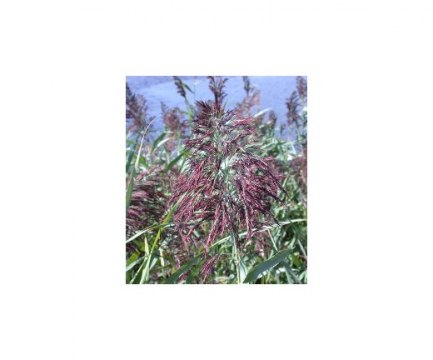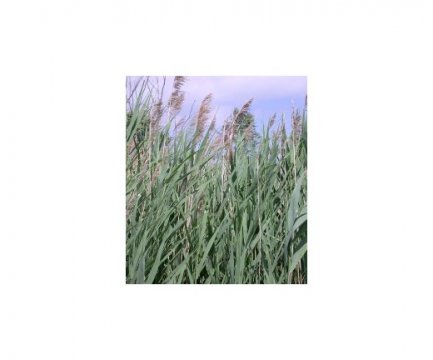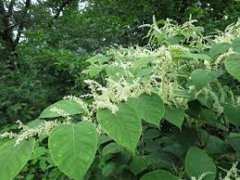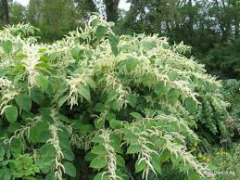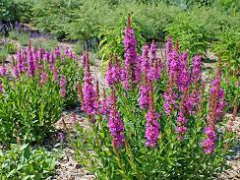LAND BASED (TERRESTRIAL) INVASIVE SPECIES
Land based invasive species are plants that were either accidentally or intentionally introduced from other places that cause harm to the things we value. Once established, invasive species can negatively impact water quality, wildlife, agriculture, recreation, forestry, human heath, the environment, and the economy. While there are many such invasives found in Vermont, the invasives which are most prominent in the area around Lake Seymour and its watershed are Phragmites (aka Common Reed), Japanese Knotweed and Purple Loosestrife. It is worth our time and effort to be able to recognize and attempt to control the spread of these invasives when found on our properties.
SEE CONTROLLING TERRESTRIAL INVASIVES DOWN THE PAGE
PHRAGMITES
Identifying: Phragmites is a tall, perennial grass that can grow to heights of 15 feet or more. Broad, pointed leaves arise from thick, vertical stalks. The flower heads are dense, fluffy, gray or purple in color and 5.9-15.7 inches long. Flowering occurs from July to October. Phragmites grows in Vermont’s wetlands and marshes, and along river and lake shores. This plant is easy to see in August when its flower stalks are in bloom.
Threats: Phragmites replaces native grasses, sedges and herbaceous plants. It provides poor quality habitat for insects, birds and amphibians. Fish populations that reproduce in wetlands and marshes inundated with phragmites suffer higher egg and juvenile mortality. The plant also exudes allelopathic compounds from its roots, causing root death of nearby native plants.
JAPANESE KNOTWEED
Identifying: Japanese knotweed is an aggressive invasive plant species that is becoming more widespread in the State of Vermont and the northeast. It is most often found along roadsides, ditches and riverbanks. It is an upright, shrublike, herbaceous perennial that can grow to over 10 feet in height. One of the characteristics that this plant has are noticeably jointed stems leading many people to believe Japanese knotweed is actually a bamboo.
Threats: Knotweeds are capable of quickly forming dense stands where they can crowd out native vegetation. Thickets can clog small waterways and displace streamside vegetation, increasing bank erosion and lowering the quality of riparian habitat for fish and wildlife. Its roots can grow through concrete and pavement causing issues with infrastructure, utilities, drainage, septic systems, walls, and foundations. Once established, these stands are very difficult to eradicate.
PURPLE LOOSESTRIFE
Identifying: Purple loosestrife is a tall multi-stemmed perennial that can grow up to 5 feet in height. Flowering occurs in July to October, when pink to purplish flowers develop in 4-16-inch long spikes at the tops of the stems. Flowers have 5-7 petals and twice as many stamens as petals. It is native to Europe and Asia and was first introduced into North America in the early 1800s for ornamental and medicinal purposes. It grows in a variety of wet habitats, including wet meadows, marshes, riverbanks, and the edges of ponds and reservoirs. It tolerates a wide variety of moisture, nutrient, and pH conditions.
Threats: Purple loosestrife can quickly form dense stands that completely dominate the area excluding native vegetation. This plant can spread very rapidly due to its prolific seed production; each plant can produce up to 2.5 million seeds per year. Loosestrife invades both natural and disturbed wetlands and alters their ecological structure and function.
CONTROLLING TERRESTRIAL INVASIVES
After many years of recommending hand control of knotweed and phragmites many environmental groups (including the Nature Conservancy) now recommend hiring certified professional help for both manual or chemical control. Northwoods Stewardship Center is the most local certified contractor for herbicidal treatment and can be hired by lake shore owners for help with both manual and herbicidal control measures. They have staff fully licensed to do herbicidal applications.
Northwoods Stewardship Center – 802-723-6551
Meghann Carter, Conservation Science Director – [email protected]
Sam Perron, Forester and Licensed Herbicide Applicator – [email protected]
If you have a small amount of Phragmites, Knotweed or Loosestrife and would like to attempt to control it manually, these are the recommended procedures:
Control of Small Patches of Phragmites:
- For small areas, hand pulling or digging up and removing the entire plant and root can be very effective. Start pulling the plants in late June or early July.
- Collect the removed roots and vegetation and dispose of them either by placing on black plastic or any other impermeable surface such as a driveway, and allowing them to dry out completely or burning them in an appropriate burn pit. Do not compost any vegetation that is not completely dried out.
- Continuing to hand pull and disrupt the roots throughout the growing season will weaken the patch if all plants are not removed at once.
- Repeat this process annually until the plants are completely eradicated.
If the Patch of Phragmites is Too Large for Hand Pulling:
Caution!! Since common reed is a grass, cutting several times during a season at the wrong times may increase stand density.
- Hand-cut individual stems at the end of July when most of the plant’s food reserves are in the aerial portion of the plant before the flowers produce seed. Plants should be cut below the lowest leaf, leaving a 6 inch or shorter stump. Hand-held cutters, gas-powered hedge trimmers and weed whackers with a circular blade are particularly efficient. You can also cut and mulch dead stems in winter to remove them and promote germination of other species. Repeat in second year and then every three to five years.
- Cut stems should be allowed to decay in a dry area.
- Some patches may be too large to cut by hand, but repeated cutting of the perimeter of a stand can prevent vegetative expansion.
- Mow large stands of common reed annually between June and July to reduce plant vigor and stem density. Common reed will spread by seed or root pieces, so be sure to thoroughly clean all mowing equipment after its use to prevent the reed’s spread.
- After cutting, lay a sheet of black plastic over the area. Use sand bags or bricks to secure the edges and keep covered for a year. Check for new growth around the plastic.
Japanese Knotweed
Mowing/Cutting alone will not eradicate Japanese knotweed and, therefore, should only be used in combination with herbicide applications or smothering. Cutting the aboveground portion of the plant usually stimulates dormant lateral buds along the rhizome system, which then send up new shoots further away from the crown, essentially increasing the total number of stems and extending the limits of the stand. This can have a serious impact to buildings and roadway infrastructure. The cut portion of the Japanese knotweed can be left in place and allowed to dry in the sun. Once the cut stems turn tan to brown in color they are no longer a threat. If freshly cut portions of the plant are moved to another location, ensure they do not come in contact with moist soil, wetlands or surface waters where they can regenerate.
Hand pulling or digging should be limited to new populations that came in with soil containing propagules of Japanese knotweed or small young populations where only a handful of stalks occur. New occurrences in construction sites or work areas can easily be removed by grasping onto the emerging stalks and pulling. If they resist then using a shovel or spade dig adjacent to the stalk to access the rhizome. Ensure that all dug plant material is destroyed before disposing of elsewhere.
Smothering is a very effective alternative if you wish to avoid the use of herbicides. Not only does it eliminate the need for chemicals, but there are also no soil disturbance/erosion issues. Here are the general guidelines:
- Allow the knotweed to grow in the spring without attempting to control it;
- Cut the knotweed at the base and close to the ground around the first week in June (allowing for early rapid growth causes the plant to exhaust the stored carbohydrates thus weakening the rhizome system);
- Pile all of the stems on an impervious surface such as a tarp, plastic, pavement, etc. so they can dry (after turning brown the stems are no longer viable or a threat);
- Spread an adequate layer of mulch, grass clipping or other material over the cut stems to prevent them from puncturing the tarp or plastic, which will be applied in the next step;
- Cover the entire area with the biggest heavy-duty dark colored tarp you can find, or use large sheets of thick (7-mill or thicker) black plastic. If more than one tarp or sheet of plastic is used make sure to have a wide overlap of 2’ between sheets to prevent sunlight from penetrating. Also, make sure the cover material extends a few feet beyond the limit of knotweed in all directions;
- Weight the top of the tarp/plastic and seal the edges with rocks, sticks, soil, sand, mulch, etc. Do not puncture the tarp/plastic as this can allow knotweed stems to survive. If any tears or holes develop, patch them.
- If aesthetics is an issue, the tarp/plastic can be covered with attractive bark mulch or other material. If it’s on a steep slope some method of anchoring will be required to ensure the mulch doesn’t slide off into the surface water. Mulch also protects the plastic from UV photo-degradation.
- 8. After 5 years the covering material can be removed and the area replanted.
Check out this video to learn more about Japanese knotweed threats and ways to control
Purple Loosestrife
Hand-pulling is only effective for seedlings with small roots. Mowing is not recommended but may reduce the production of seeds.

